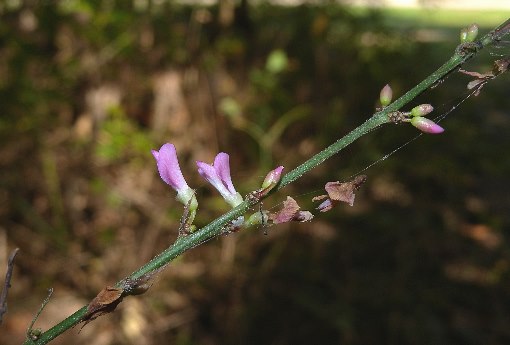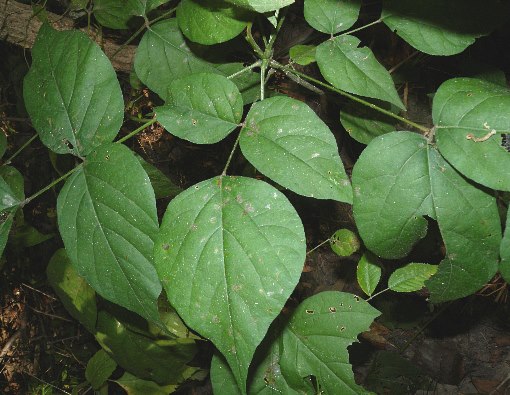
From the central stem, a narrow raceme or raceme-like panicle of flowers develops that is 1-2' long; this raceme can be erect, ascending, or lean over to one side. The central stalk of the raceme is light to medium green, terete or somewhat angular, and covered with stiff short hairs. The flowers are sparsely to moderately distributed along the central stalk on short pedicels about ¼" long. The slender pedicels are light green to reddish green and covered with short stiff hairs. Individual flowers are up to 1/3" (8 mm.) long with a typical pea-like floral structure consisting of a banner, 2 lateral wings, and 2 petals that form an inner keel. These petals are light pink to rosy pink. Each flower has a light green to whitish green calyx that is short-tubular with shallow lobes; it is often ciliate or slightly hairy.

The blooming period occurs during the summer for about 1-2 months. Usually, relatively few flowers are in bloom at the same time. There is no noticeable floral scent. The flowers are later replaced by flattened loments (seedpods) about ½-1½" long; these loments are initially green, they later turn brown at maturity. The sides of each loment are covered with short hooked hairs. Each loment is divided into 1-4 segments (each one about 1/3" or 8 mm. long); the segments have upper sides that are slightly concave and lower sides that are convex or angular-convex. At the front of each loment, there is a narrow stipe about ¼" long. Each loment can break apart along each pair of its segments; each segment contains a single reniform seed that is somewhat flattened. The root system consists of a taproot.
Cultivation: The preference is partial sun to medium shade, moist to dry-mesic conditions, and loamy soil with decaying organic matter. However, clay-loam and rocky soil are also tolerated.
Range & Habitat: The native Pointed-Leaved Tick Trefoil is occasional throughout Illinois, except for some areas of southern Illinois, where it is uncommon or absent. Habitats consist of upland woodlands that are often rocky, moist to mesic woodlands, woodland borders along roads and railroads, and areas along woodland paths. This wildflower can be found in both disturbed and higher quality woodlands that are dominated by various deciduous trees.
Faunal Associations: Robertson (1929) observed the Halictid bee, Lasioglossum versatus, collecting pollen from the flowers. Other insects that may visit the flowers include bumblebees and other long-tongued bees. While the caterpillars of several butterflies and skippers feed on the foliage of Desmodium spp. (Tick Trefoils), they are usually found in savannas and prairies, rather than the shady woodlands that Pointed-Leaved Tick Trefoil prefers. Other insects that feed on this group of plants include the aphid Microparsus variabilis, the thrips Echinothrips americanus and Neohydatothrips desmodianus, the leaf-mining larvae of the Buprestid beetles Pachyschelus confusus and Pachyschelus laevigatus, the larvae of the seed weevil Apion decoloratum, and several leaf beetles: Anomoea laticlavia, Bassareus lituratus, Cerotoma trifurcata, Colapsis brunnea, Cryptocephalus insertus, Odontata dorsalis, Pachybrachis nigricornis, Pachybrachis othonus, Phyllecthris dorsalis, and Saxinis omogera. Some vertebrate animals also use Tick Trefoils as a food source: the Wild Turkey and Bobwhite eat the seeds, while the White-Tailed Deer, Cottontail Rabbit, and various domesticated animals (cattle, horses, sheep, etc.) browse on the foliage. The seed-bearing loments have the capacity to cling to the feathers of birds, fur of mammals, and clothing of humans: in this manner, the seeds are spread to new areas.
Photographic Location: Along a woodland path of a state park in east-central Illinois.

Comments: Pointed-Leaved Tick Trefoil is relatively easy to identify because it is one of two species of its genus within Illinois that produces a single pseudo-whorl of leaves. The other species that has this characteristic, Desmodium nudiflorum (Naked-Flowered Tick Trefoil), differs by producing its inflorescence on a naked stalk that is entirely separate from the central stem of its leaves. The inflorescence of Pointed-Leaved Tick Trefoil is produced above its pseudo-whorl of leaves; they both derive from the same central stem. Other Desmodium spp. (Tick Trefoils) produce their leaves alternately along their stems, instead of being bunched together in a pseudo-whorl.